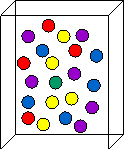|
|
|
1.
|
A bag contains red, blue, yellow, purple, and green marbles. Use this diagram to
answer the following questions.
 Select the more reasonable
statement. a. | The probability of taking out a green marble is greater than the probability of
taking out a red marble. | b. | The probability of taking out a red marble is
less than the probability of taking out a green marble. | c. | The probability of
taking out a yellow marble is less than taking out a green marble. | d. | The probability of
taking out a purple marble is greater than taking out a blue marble. |
|
|
|
2.
|
Select the more reasonable statement.
a. | The probability of taking out a blue marble is greater than the probability of taking
out a purple marble. | b. | The probability of taking out a red marble is
less than the probability of taking out a yellow marble. | c. | The probability of
taking out a blue marble is less than the probability of taking out a green
marble. | d. | The probability of taking out a red marble is greater than the probability of taking
out a yellow marble. |
|
|
|
3.
|
Which outcome is more likely to occur?
a. | taking out a purple marble | c. | taking out a blue
marble | b. | taking out a green marble | d. | taking out a red marble |
|
|
|
4.
|
Which outcome is less likely to occur?
a. | taking out a red marble | c. | taking out a green
marble | b. | taking out a yellow marble | d. | taking out a purple marble |
|
|
|
5.
|
Which two marbles are equally likely to be taken out of the bag?
a. | yellow and green | c. | blue and red | b. | blue and yellow | d. | purple and red |
|
|
|
6.
|
Maria’s coin jar contains 40 coins. Use this table to answer the following
questions. Coin | Number of coins | | Toonie | 5 | | Loonie | 4 | | Quarter | 8 | | Dime | 5 | | Nickel | 6 | | Penny | 12 | | |
Which coin is Maria more likely to pick from
the jar? a. | penny | b. | toonie | c. | nickel | d. | quarter |
|
|
|
7.
|
Which coin is Maria less likely to pick from the jar?
a. | dime | b. | penny | c. | quarter | d. | loonie |
|
|
|
8.
|
Which coins are equally likely to be picked from the jar?
a. | penny and loonie | c. | quarter and loonie | b. | toonie and dime | d. | dime and penny |
|
|
|
9.
|
Select the more reasonable statement.
a. | Picking a quarter is more likely than picking a penny. | b. | Picking a nickel is
less likely than picking a toonie. | c. | Picking a loonie is less likely than picking a
dime. | d. | Picking a loonie is more likely than picking a
quarter. |
|
|
|
10.
|
Select the more reasonable statement.
a. | Picking a dime is more likely than picking a toonie. | b. | Picking a penny is
less likely than picking a nickel. | c. | Picking a nickel is less likely than picking a
dime. | d. | Picking a quarter is more likely than picking a
toonie. |
|